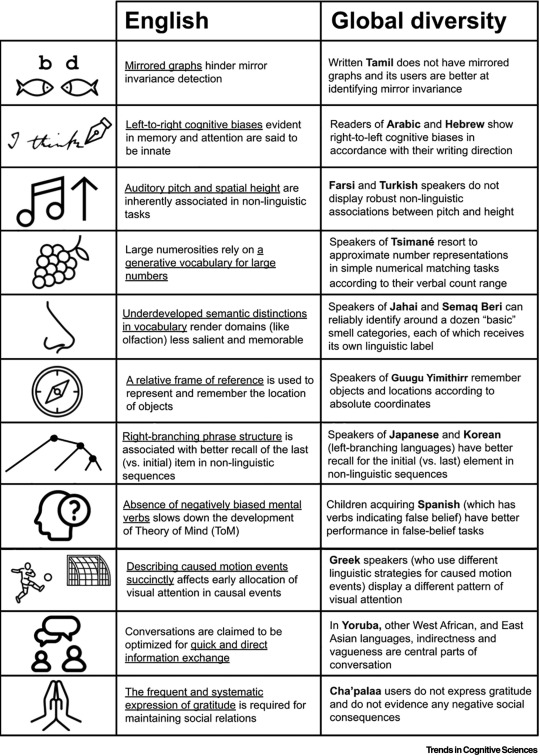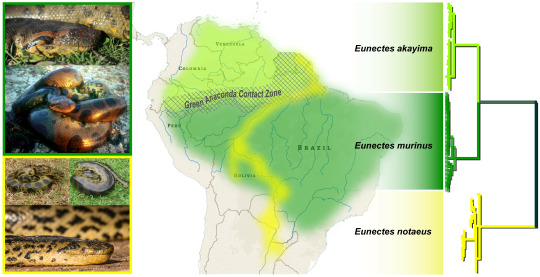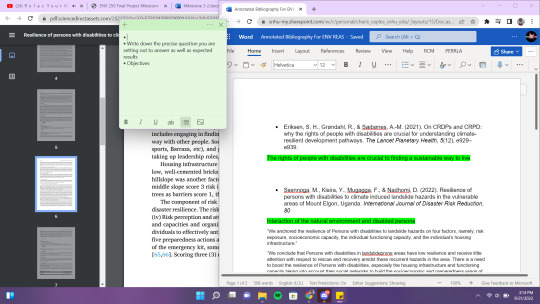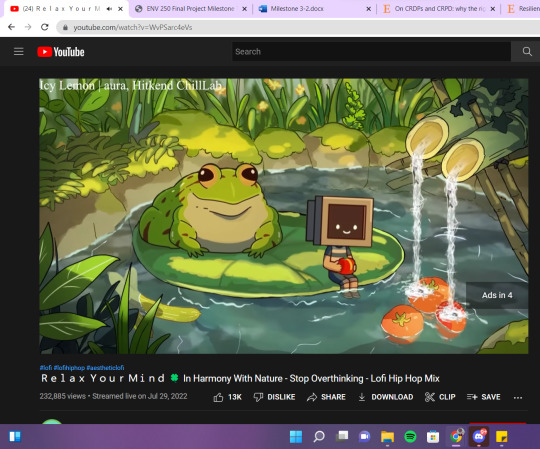#scientific paper
Text

21K notes
·
View notes
Text
A Brief Summary of the Anaconda News
This post is about "Disentangling the Anacondas: Revealing a New Green Species and Rethinking Yellows"
Please note this post is not an analysis of the veracity of this paper, it is simply a summary of the findings.
This research team performed genetic testing on known species within the Anaconda genus (Eunectes). They are suggesting two things in their paper:
Two recognized species of yellow anacondas, E. beniensis and E. deschauenseei, are not significantly genetically distinct from E. notaeus. Note that E. notaeus has a slightly different pattern/morphology while the other two are more similar and differentiated mostly by location. They propose grouping these all three as one species.
The Green Anaconda, the heaviest species of snake, with a range all across the continent, may actually be two species. They found significant genetic differences between Northern and Southern Green Anacondas and are proposing they be made into separate species.

Graphical Abstract, sourced from linked paper, showing revised taxonomy. The Northern Green Anaconda's proposed scientific named is E. akayima. Akayima means "The Great Snake" in the indigenous language of the region.
The paper points out that there are conservation implications behind redefining these species. If the Northern Green Anaconda is accepted as a separate species, habitat loss may impact it more severely than the Southern, who has a wider range. For the the opposite reason, scientists may feel reluctant to group three previously defined species into one, as it could make it more difficult to protect the subcategories.
Read more: Nat Geo article on the findings, Bryan Fry Live Science article
Oh yeah, and one of the scientists who published the article posted this video of an Anaconda that's estimated to be 8 meters long and 200kg. Here's a still:

big dog
394 notes
·
View notes
Text
Love my friend dearly, but I also have to share this with all of you as an MLA lover and English enthusiast. My friend was working next to me on a five-page essay for a science class, and using the initial draft she got feedback on to make adjustments, I started helping her with some general things.
And after I start to revise... everything starts moving—moving like I just slapped an image in the middle of a Word document. I investigate, and there is a manual space between every line...
I question her, and this poor woman goes, "Oh, it's supposed to be double space since it's MLA format." I had a heart attack right then and there; I'm surprised I'm alive.
I showed her where the line spacing settings are. I asked ChatGPT to remove all the paragraph spaces from the essay and then fixed it for her in her document. I put her details in the heading and showed her the citation tool, then shared my MLA format template with her. I also encouraged her to come to me if she ever has an academic question or wonders if something seems unnecessarily difficult to execute.
It was horrific and I feel bad that she's gone through school like this, if only schools made sure their students were taught what they require of them.
Extra little fun detail:
I asked if she ran it through Grammarly, and she asked me how to do that
DON'T WORRY; I AM HERE TO HELP AND SUPPORT YOU!!!!!!!!!!
#mla format#student#english#writing#paper#essays#essay#writer things#science#scientific paper#friends#silly little guy#goofy#grammar#formatting#grammatical errors#writers on tumblr#lol#funny#humor#real conversation#real events#text post#haha#original post#textpost#shit post#shitpost
19 notes
·
View notes
Text
I kid you not, when I was in my Arcane phase, I took a research course which involved writing a scientific paper based on a series of experiments. And I just pretended I was doing hex research to keep myself motivated and I ended up winning a RESEARCH AWARD for my work. Literally graduated with a distinction in research, got a cute little pin, took a photo with the dean and everything. Didn't have the heart to tell anyone that my motivation was two fictional scientists and their glowing blue orbs.
#arcane#fanfiction#arcane victor#victor arcane#arcane jayce#confession#science#scientist#funny story#fandom#fandoms#scientific paper#science side of tumblr#arcane memes#arcane hex#hexcore
294 notes
·
View notes
Text
“Let’s do a careful review of the available evidence... by going directly to the conclusions, of course.”
Kids, don’t try this at home.
39 notes
·
View notes
Text

Just wanted to say that I'm extremely proud of my second baby (aka my second scientific paper that I published this year).
For more scientific content, visit loving.microbiology
#science#microbiology#immunology#medicine#med student#veterinary medicine#scientific paper#scientific Symposium#veterinary medicine student#fmvb#veterinary medicine Bucharest#romania#mine#personal stuff#bacteria#experiments#laboratory medicine#yall need science#5th may 2023#quail eggs#microbiologist#lysozyme#plants#romanian medical student#romanian sciencist in progress#women in science
23 notes
·
View notes
Text
The study shows that in prehistoric Patagonia, these predators included dinosaurs from two groups: Megaraptoridae and Unenlagiinae.
Enantiornithines: were the most diverse and abundant birds millions of years ago; they resembled sparrows, but with beaks lined with teeth.
Ornithurae includes all modern birds living today; the ornithurines living in ancient Patagonia may have resembled a goose or duck, though the fossils are too fragmentary to tell for sure.
You’ve got your large theropod carnivores and smaller carnivores as well as these bird groups coexisting alongside other reptiles and small mammals.”
#paleontology#biology#dinosaurs#birds#science#scientific discovery#fossils#chile#cretaceous period#evolution#article#scientific paper
3 notes
·
View notes
Text
Fossil findings suggest cave lion hunting for fur in Spain, ~16.800 years ago
Here is a summary and some citations of the following paper:
Under the skin of the lion: unique evidence of upper paleolithic exploitation and use of cave lion (Panthera spelaea) from the lower gallery of La Garma (Spain). Marián Cueto et al, 2016. PlosOne.
Links:
- The original paper
- A printable PDF version
- Popular scientific artible
The researchers carbon dated and analysed human caused cut marks on the distal phalanges (claws) of one cave lion individual found in Spain. The cut marks and location of the claw bones found in the archeological site, indicate the use of cave lion fur by which the claws are meant to remain attached to the pelt, although this is hard to confirm from fossil analysis.
The results suggest that paleolithic humans living around 16800 BP in Spain hunted and skinned cave lions. The data are insufficient to draw conclusions about the scale in which this happened. The authors say that cave lion hunting could have been sporadic given the very few fossils found with human caused cut marks. However, they also say that by means of extrapolation from both archeological data as well as from data on modern lions, that cave lion (and generally large carnivore) hunting could have happened at larger scale which may have contributed to cave lion extinction in Europe.
---------------------------------------------------------------
Abstract (the author's summary)
"Pleistocene skinning and exploitation of carnivore furs have been previously inferred from archaeological evidence. Nevertheless, the evidence of skinning and fur processing tends to be weak and the interpretations are not strongly sustained by the archaeological record. In the present paper, we analyze unique evidence of patterned anthropic modification and skeletal representation of fossil remains of cave lion (Panthera spelaea) from the Lower Gallery of La Garma (Cantabria, Spain). This site is one of the few that provides Pleistocene examples of lion exploitation by humans. Our archaeozoological study suggests that lion-specialized pelt exploitation and use might have been related to ritual activities during the Middle Magdalenian period (ca. 14800 cal BC). Moreover, the specimens also represent the southernmost European and the latest evidence of cave lion exploitation in Iberia. Therefore, the study seeks to provide alternative explanations for lion extinction in Eurasia and argues for a role of hunting as a factor to take into account".
Some citations from the discussion
"In Western Europe there are also cave lion fossils (e.g., (49) and references therein, (50, 51) but only a few has human modifications (52). Those remains with evidence of anthropic taphonomic damage indicate exceptional lion hunting events and exploitation related to use of the skin, tendons, and teeth as raw materials (14,27) ."
"An interesting note is that these marks are present in same zones associated with the modern veterinary operation of declawing (onychectomy surgery) of domestic felines (53). Moreover, this is also the technique used by modern hunters when skinning their prey when the aim is to keep the claws attached to the fur."
"The presence of carnivores in Pleistocene and Holocene sites is commonly associated with fur use (e.g. 54,65). The inferred exploitation patterns can be linked with large and small carnivore pelt exploitation (e.g., 15,17,19, 25, 66, 67), according to historic, ethnographic, and actualistic observations for fur procurement resulting in usable carnivore skins (68, 70), which are also applicable to the _LG_ cave lion remains."
"The hypothesis of the presence of a single lion would suggest a sporadic, isolated, and rare event of large carnivore hunting, as indicated (although other scenarios cannot be excluded, like scavenging) in ancient chronologies (15). However, the well-defined pattern inferred from the locations of the cut-marks and scraping traces permits us to infer an experienced procedure and a high knowledge of animal anatomy. Furthermore, the presence of the remains of other carnivores, such as bears (_Ursus arctos_), at the site that also show anthropic modifications, reveal the successful hunting of dangerous carnivores, as has also been observed at other Magdalenian sites (e.g., 52,67,82)."
"The potential linkage of the presence of a cave lion skin in such an archaeological context with ritual activities (35) allows us to infer a probable important role of the cave lion during the Magdalenian period among human groups."
“Although these remains are not sufficient to allow conclusive statements to be made, they sum the data to highlight the role of human activity in the extinction of carnivores, as has been suggested for other geographical areas, in addition to other factors such as climate change, prey numbers, or species replacement (e.g., 23-30) also summarized in (31))."
"Modern case studies have demonstrated that a decrease in extant African lions can be related to direct human intervention through rapid habitat destruction, depletion of resources, and over-hunting (91,92) In this sense, we associate this well-defined lion skinning exploitation pattern from _LG_ with a previously practiced activity reached through intense hunting during the Upper Paleolithic. A tentative proposal might be to link this knowledge to an important role in human culture resulting in a key factor that should be taken into account to understand cave lion extinction."
Conclusion
"In conclusion, we suggest that this outstanding evidence of specialized and patterned skinning exploitation of cave lions in the Upper Paleolithic, as inferred in _LG_, can be viewed as a complex hominin-carnivore interaction scenario. Its association with ritual activities provides key evidence for approaching behavioral issues in relation to cultural traditions and speculative alternative explanations to cave lion extinction during the Late Pleistocene, assuming a role for human hunting as a determining factor, among others. Further research will be needed to test this hypothesis, for answer to the questions addressed in order to contribute to the debate with new data, although the problem is a complex one."
---------------------------------------------------------------
> The numbers are the references that you can find in the original paper.
> I may post more summary/citation compilations like this about various topics.
#scientific article#scientific paper#paleobiology#cave lion#hunting#science#biology#human-carnivore interaction
11 notes
·
View notes
Text

I wish all scientific papers allowed themselves to be this fun
this was just one sentence, yet it made the entire reading + writing on it experience so much better
19 notes
·
View notes
Text

2 notes
·
View notes
Text
And other underappreciated research about human reproduction, which I came across when googling something unrelated.
#I was trying to source an incorrect quote#which is a normal thing to do#biology#human biology#science#scientific paper
5 notes
·
View notes
Text


🐸It’s not easy being green. Last few terms (equivalent to last semester) of my B.S in Environmental Science. I am oscillating between the “I’m Fine” dog, and the “I’VE GOT THE POWER OF GOD AND ANIME ON MY SIDE” kid. So.
🌿Favorite Iconique™️ meme?
#growing nerd#clutter#screen cap#frog#lo fi#lo fi aesthetic#youtube#research#notes#annotations#scientific paper#senior year#meme#academics unite#green#environmental science major#science major#bachelor of science#studyblr#green aesthetic#online student#online degree#cartoon#cute
4 notes
·
View notes
Text
reading a scientific paper and it's a thought you had when you were an 11 year old little girl
0 notes
Text
From 1930 to the end of the Second World War, about a quarter of the human geneticists in the United States and Britain produced more than sixty percent of the published papers, and about a tenth – a cadre of leaders totaling fewer than twenty people – were responsible for some forty percent, including the corpus of fundamental work that established the methodological foundations of the field.
"In the Name of Eugenics: Genetics and the Uses of Human Heredity" - Daniel J. Kevles
#book quote#in the name of eugenics#daniel j kevles#nonfiction#30s#1930s#40s#1940s#20th century#ww2#wwii#world war 2#world war ii#world war two#second world war#genetics#united states#britain#scientific paper#publishing#methodology#foundations
0 notes
Text

Another one 🥹🩷
#personal stuff#papers#Science#Research#medicine#pathology#morphopathology#med student#researcher#veterinary medicine#veterinary medicine student#scientific paper#Symposion#symposium#Timișoara#romania#2023#publishing#brain#melopsittacus undulatus#budgies#science#scientist#personal paperwork
3 notes
·
View notes
Text
Paleontologists analyzed five fossils of an early Cretaceous bird, Sapeornis chaoyangensis, in order to study how the environment they were buried in changed the preservation of their soft tissue.
The site of Jehol Biota in China is famous for stunning fossils which preserve soft tissue—skin, organs, feathers, and fur.
The most likely explanation for how well the fossil is preserved is that the bird was swept away by a rainstorm and rapidly buried at the bottom of a lake, where a restricted burial environment ensured it wasn't disturbed. It is unlikely that it was from volcanic activity Since fossils in pyroclastic flows don't preserve soft tisdue
Discovery of five specimens of early bird Sapeornis chaoyangensis
The Jehol Biota, one of the most important Mesozoic fossil Lagerstätten, comprises extraordinary taxonomic diversity of micro- and megaplants, invertebrates, and vertebrates; moreover, it provides the most informative source for understanding Mesozoic ecology.
Fossil soft tissues contain important and irreplaceable information on life evolution, and on the comprehensive understanding of the nature of Mesozoic ecosystems. Compared to other fossil soft tissues, Jehol Biota feathers are more commonly reported. However, taphonomic analysis of these feathers is lacking. Here,
#paleontology#fossil#mesozoic#birds#feathers#science#biology#article#scientific research#discovery#scientific paper#scientific discovery
3 notes
·
View notes